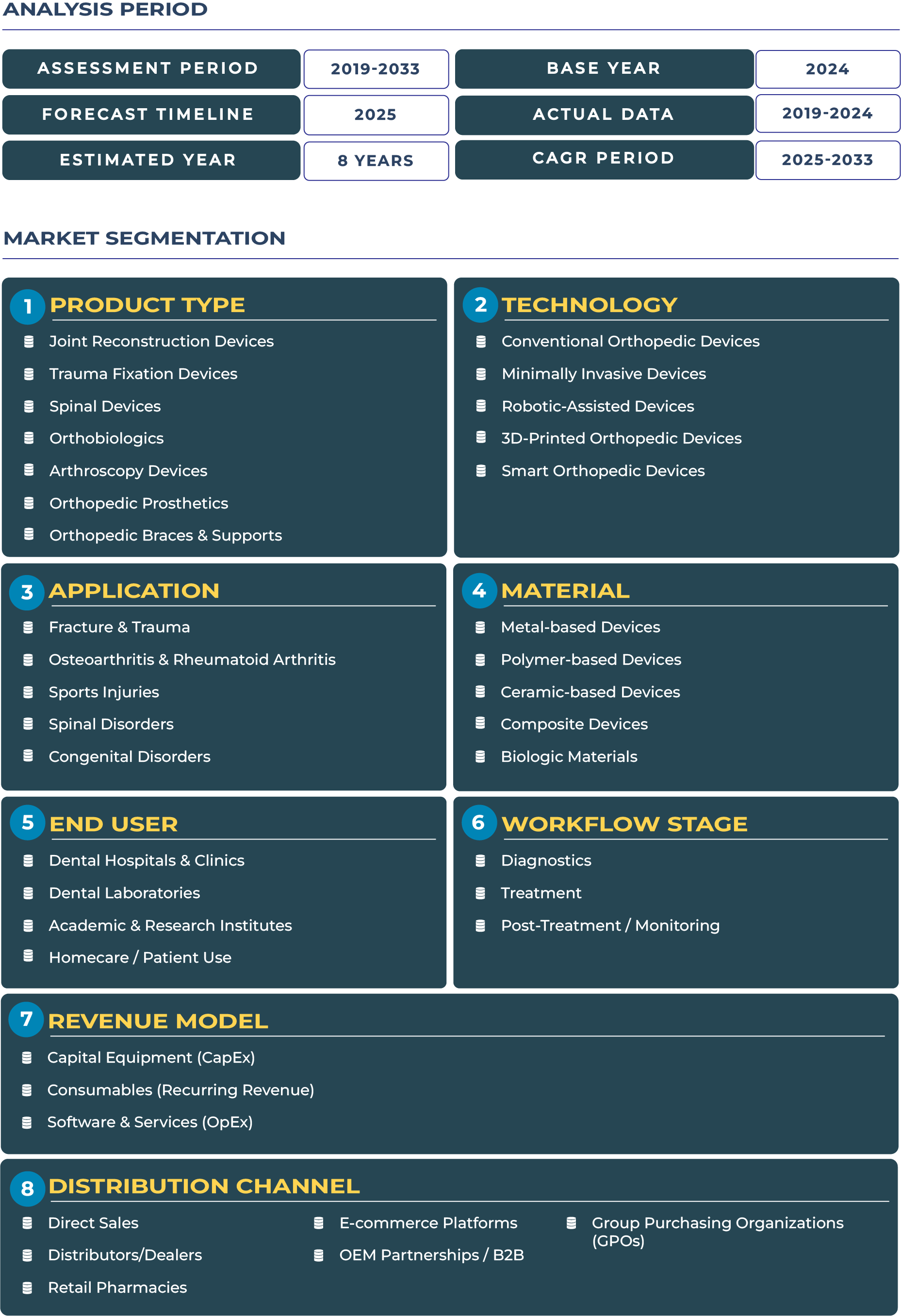Introduce with Kuwait’s High-Value but Smaller Orthopedic Market Demand
Kuwait Orthopedic Devices market presents a unique case within the Gulf region. Unlike larger neighbors, its healthcare sector is relatively small in scale but commands high value due to the country’s wealthy population and strong demand for premium care solutions. Patients in Kuwait often expect advanced implants, minimally invasive procedures, and high-ASP (average selling price) devices sourced from leading global manufacturers. In 2025, the Kuwait orthopedic devices market is estimated to reach USD 29.3 million, and it is projected to expand to USD 36.5 million by 2033, at a CAGR of 2.8%. While the growth rate is moderate compared to other GCC markets, its performance is underpinned by focused modernization projects, well-funded hospital upgrades, and an emphasis on offering world-class treatment for orthopedic trauma, spinal disorders, and joint reconstruction. The orthopedic devices sector in Kuwait is thus characterized by smaller volume but high-value imports, aligning with the country’s healthcare priorities of quality over quantity.
Wealth-Backed Premium Demand Ensuring Steady Orthopedic Growth
The orthopedic devices industry in Kuwait benefits from robust public healthcare funding and a population with high disposable income, which together sustain steady demand for advanced surgical interventions. Despite being a relatively small market in terms of scale, Kuwait’s healthcare system has consistently focused on quality outcomes, leveraging international device imports to ensure best-in-class patient care. Elective surgeries such as knee and hip replacements are increasingly performed with advanced implants, while spinal devices are witnessing rising adoption as lifestyle-related spinal conditions gain prevalence. Trauma fixation devices remain essential due to road accidents and workplace injuries, creating a steady flow of procedural demand. Orthobiologics and arthroscopy devices are also gaining attention, as sports medicine and regenerative practices gain traction in both public and private hospitals. Looking forward, Kuwait Orthopedic Devices landscape will remain stable, supported by its wealth-backed healthcare priorities and the country’s strategy of aligning with global medical best practices.
Drivers and Restraints: Balancing High-Value Demand with Market Size Constraints
A key driver for Kuwait Orthopedic Devices ecosystem is its high per-capita healthcare spending. With one of the highest per-capita incomes globally, the Kuwaiti population places strong emphasis on accessing advanced implants and niche orthopedic solutions. The country’s small but well-funded healthcare sector is actively pursuing modernization, with hospital expansions and digitalization projects creating new demand for orthopedic technologies. Focused investment in boutique private hospitals, often catering to high-net-worth individuals, further increases demand for premium devices and specialized procedures.
However, the orthopedic devices market in Kuwait faces restraints due to its very limited scale compared to larger GCC neighbors. The small market size reduces economies of scale for manufacturers and distributors, restricting broad product availability. Procurement concentration, with most imports routed through a few large tenders, limits opportunities for new entrants. Additionally, talent competition across the Gulf, particularly for highly specialized orthopedic surgeons, creates workforce challenges. This talent gap slows adoption of advanced surgical devices that require specialized training and expertise. These challenges underscore the need for manufacturers to adopt flexible, service-driven approaches to maximize opportunities in Kuwait Orthopedic Devices sector.
Trends and Opportunities: Boutique Healthcare Projects and Niche Device Expansion
Kuwait Orthopedic Devices industry is witnessing targeted hospital upgrades, particularly within the Ministry of Health system, which is strengthening surgical capacity with advanced equipment. Private sector boutique hospitals in Kuwait City and other urban centers are increasingly offering premium orthopedic services such as robotic-assisted surgery and advanced spinal procedures, reflecting a trend toward high-ASP device adoption. This focus on quality and niche care delivery ensures that the orthopedic devices landscape is aligned with patient expectations for premium healthcare outcomes.
Significant opportunities exist for orthopedic device manufacturers to partner with boutique hospitals and specialized clinics in Kuwait. Managed service deals, where suppliers provide equipment and training alongside long-term service agreements, are proving attractive to smaller facilities seeking to minimize upfront capital expenditure. Premium niche implants, such as patient-specific joint replacements and high-performance prosthetics, are also gaining market traction. Additionally, opportunities for surgical training academies that focus on high-precision orthopedic techniques are emerging, helping to bridge the talent gap and create local expertise. These dynamics highlight how the orthopedic devices sector in Kuwait, though small, offers lucrative opportunities for companies focused on specialized, premium solutions.
Competitive Landscape: Premium Imports and Localization of Niche Orthopedic Care
The competitive environment in Kuwait Orthopedic Devices market is shaped by strong international presence and selective local collaborations. Companies such as Stryker, Zimmer Biomet, Smith & Nephew, and DePuy Synthes remain the dominant suppliers of premium implants, trauma fixation devices, and spinal solutions. These firms are increasingly adopting strategies tailored to Kuwait’s boutique healthcare market, such as offering managed services for smaller hospitals, introducing niche premium implants, and providing training programs to local staff. Local distributors play a critical role in navigating procurement cycles and ensuring supply continuity. Recent developments include expansion of robotic-assisted orthopedic surgery options in leading hospitals and increased availability of high-performance prosthetics to serve Kuwait’s rehabilitation sector. The orthopedic devices landscape is thus characterized by premium imports, selective partnerships, and an emphasis on knowledge transfer, ensuring sustainable growth in a compact but wealthy healthcare market.







